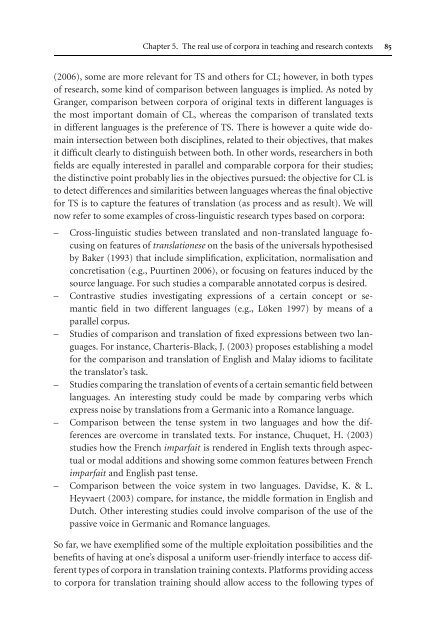Topics in Language Resources for Translation ... - ymerleksi - home
Topics in Language Resources for Translation ... - ymerleksi - home
Topics in Language Resources for Translation ... - ymerleksi - home
- No tags were found...
Create successful ePaper yourself
Turn your PDF publications into a flip-book with our unique Google optimized e-Paper software.
Chapter 5. The real use of corpora <strong>in</strong> teach<strong>in</strong>g and research contexts 85(2006), some are more relevant <strong>for</strong> TS and others <strong>for</strong> CL; however, <strong>in</strong> both typesof research, some k<strong>in</strong>d of comparison between languages is implied. As noted byGranger, comparison between corpora of orig<strong>in</strong>al texts <strong>in</strong> different languages isthe most important doma<strong>in</strong> of CL, whereas the comparison of translated texts<strong>in</strong> different languages is the preference of TS. There is however a quite wide doma<strong>in</strong><strong>in</strong>tersection between both discipl<strong>in</strong>es, related to their objectives, that makesit difficult clearly to dist<strong>in</strong>guish between both. In other words, researchers <strong>in</strong> bothfields are equally <strong>in</strong>terested <strong>in</strong> parallel and comparable corpora <strong>for</strong> their studies;the dist<strong>in</strong>ctive po<strong>in</strong>t probably lies <strong>in</strong> the objectives pursued: the objective <strong>for</strong> CL isto detect differences and similarities between languages whereas the f<strong>in</strong>al objective<strong>for</strong> TS is to capture the features of translation (as process and as result). We willnow refer to some examples of cross-l<strong>in</strong>guistic research types based on corpora:– Cross-l<strong>in</strong>guistic studies between translated and non-translated language focus<strong>in</strong>gon features of translationese on the basis of the universals hypothesisedby Baker (1993) that <strong>in</strong>clude simplification, explicitation, normalisation andconcretisation (e.g., Puurt<strong>in</strong>en 2006), or focus<strong>in</strong>g on features <strong>in</strong>duced by thesource language. For such studies a comparable annotated corpus is desired.– Contrastive studies <strong>in</strong>vestigat<strong>in</strong>g expressions of a certa<strong>in</strong> concept or semanticfield <strong>in</strong> two different languages (e.g., Löken 1997) by means of aparallel corpus.– Studies of comparison and translation of fixed expressions between two languages.For <strong>in</strong>stance, Charteris-Black, J. (2003) proposes establish<strong>in</strong>g a model<strong>for</strong> the comparison and translation of English and Malay idioms to facilitatethe translator’s task.– Studies compar<strong>in</strong>g the translation of events of a certa<strong>in</strong> semantic field betweenlanguages. An <strong>in</strong>terest<strong>in</strong>g study could be made by compar<strong>in</strong>g verbs whichexpress noise by translations from a Germanic <strong>in</strong>to a Romance language.– Comparison between the tense system <strong>in</strong> two languages and how the differencesare overcome <strong>in</strong> translated texts. For <strong>in</strong>stance, Chuquet, H. (2003)studies how the French imparfait is rendered <strong>in</strong> English texts through aspectualor modal additions and show<strong>in</strong>g some common features between Frenchimparfait and English past tense.– Comparison between the voice system <strong>in</strong> two languages. Davidse, K. & L.Heyvaert (2003) compare, <strong>for</strong> <strong>in</strong>stance, the middle <strong>for</strong>mation <strong>in</strong> English andDutch. Other <strong>in</strong>terest<strong>in</strong>g studies could <strong>in</strong>volve comparison of the use of thepassive voice <strong>in</strong> Germanic and Romance languages.So far, we have exemplified some of the multiple exploitation possibilities and thebenefits of hav<strong>in</strong>g at one’s disposal a uni<strong>for</strong>m user-friendly <strong>in</strong>terface to access differenttypes of corpora <strong>in</strong> translation tra<strong>in</strong><strong>in</strong>g contexts. Plat<strong>for</strong>ms provid<strong>in</strong>g accessto corpora <strong>for</strong> translation tra<strong>in</strong><strong>in</strong>g should allow access to the follow<strong>in</strong>g types of
















